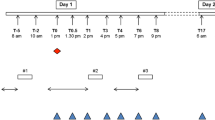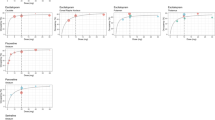Abstract
While serotonin 5HT2-receptors have been implicated in the etiology and pharmacological treatment of a number of neuropsychiatric conditions, there are few potent and specific agents available for use in human clinical studies. EMD 281014 is a highly specific 5HT2-receptor antagonist that is currently under development. To find optimal doses for early clinical studies, we conducted a PET study using [18F]setoperone in nine healthy subjects scanned at baseline and following the administration of 1, 3, and 7 mg EMD 281014. The study drug was well tolerated by all study participants, and all doses resulted in ≥70% occupancy at frontal 5HT2-receptors 3 h after drug administration. The data suggest that daily dosing of ≥3 mg EMD 281014 should be sufficient to provide sustained high levels of 5HT2-receptor occupancy in future clinical trials.


Similar content being viewed by others
References
Andree B, Nyberg S, Ito H, Ginovart N, Brunner F, Jaquet F, Halldin C, Farde L (1998) Positron emission tomographic analysis of dose-dependent MDL 100,907 binding to 5-hydroxytryptamine-2A receptors in the human brain. J Clin Psychopharmacol 18:317–323
de Angelis L (2002) 5-HT2A antagonists in psychiatric disorders. Curr Opin Invest Drugs 3:106–112
Bartoszyk GD, van Amsterdam C, Bottcher H, Seyfried CA (2003) EMD 281014, a new selective serotonin 5-HT2A receptor antagonist. Eur J Pharmacol 473:229–230
Blin J, Pappata S, Kiyosawa M, Crouzel C, Baron JC (1988) [18F]setoperone: a new high-affinity ligand for positron emission tomography study of the serotonin-2 receptors in baboon brain in vivo. Eur J Pharmacol 147:73–82
Blin J, Sette G, Fiorelli M, Bletry O, Elghozi JL, Crouzel C, Baron JC (1990) A method for the in vivo investigation of the serotonergic 5-HT2 receptors in the human cerebral cortex using positron emission tomography and 18F-labeled setoperone. J Neurochem 54:1744–1754
Bubser M, Backstrom JR, Sanders-Bush E, Roth BL, Deutch AY (2001) Distribution of serotonin 5-HT(2A) receptors in afferents of the rat striatum. Synapse 39:297–304
Carson RE, Breier A, de Bartolomeis A, Saunders RC, Su TP, Schmall B, Der MG, Pickar D, Eckelman WC (1997) Quantification of amphetamine-induced changes in [11C]raclopride binding with continuous infusion. J Cereb Blood Flow Metab 17:437–447
Crouzel C, Venet M, Irie T, Sanz G, Boullais C (1988) Labeling of a serotoninergic ligand with 18F: [18F] setoperone. J Label Compd Radiopharm 25:403–414
Grunder G, Yokoi F, Offord SJ, Ravert HT, Dannals RF, Salzmann JK, Szymanski S, Wilson PD, Howard DR, Wong DF (1997) Time course of 5-HT2A receptor occupancy in the human brain after a single oral dose of the putative antipsychotic drug MDL 100,907 measured by positron emission tomography. Neuropsychopharmacology 17:175–185
Hall H, Farde L, Halldin C, Lundkvist C, Sedvall G (2000) Autoradiographic localization of 5-HT(2A) receptors in the human brain using [(3)H]M100907 and [(11)C]M100907. Synapse 38:421–431
Hutson PH, Barton CL, Jay M, Blurton P, Burkamp F, Clarkson R, Bristow LJ (2000) Activation of mesolimbic dopamine function by phencyclidine is enhanced by 5-HT(2C/2B) receptor antagonists: neurochemical and behavioural studies. Neuropharmacology 39:2318–2328
Kapur S, Jones C, DaSilva J, Wilson A, Houle S (1997) Reliability of a simple non-invasive method for the evaluation of 5-HT2 receptors using [18F]-setoperone PET imaging. Nucl Med Commun 18:395–399
Lammertsma AA, Hume SP (1996) Simplified reference tissue model for PET receptor studies. Neuroimage 4:153–158
Lammertsma AA, Bench CJ, Hume SP, Osman S, Gunn K, Brooks DJ, Frackowiak RS (1996) Comparison of methods for analysis of clinical [11C]raclopride studies. J Cereb Blood Flow Metab 16:42–52
Masand PS, Gupta S (2002) Long-term side effects of newer-generation antidepressants: SSRIS, venlafaxine, nefazodone, bupropion, and mirtazapine. Ann Clin Psychiatry 14:175–182
Maziere B, Crouzel C, Venet M, Stulzaft O, Sanz G, Ottaviani M, Sejourne C, Pascal O, Bisserbe JC (1988) Synthesis, affinity and specificity of 18F-setoperone, a potential ligand for in-vivo imaging of cortical serotonin receptors. Int J Rad Appl Instrum B 15:463–468
Meltzer HY (1999) The role of serotonin in antipsychotic drug action. Neuropsychopharmacology 21:106S–115S
Meltzer HY, Matsubara S, Lee JC (1989a) Classification of typical and atypical antipsychotic drugs on the basis of dopamine D-1, D-2 and serotonin2 pKi values. J Pharmacol Exp Ther 251:238–246
Meltzer HY, Matsubara S, Lee JC (1989b) The ratios of serotonin2 and dopamine2 affinities differentiate atypical and typical antipsychotic drugs. Psychopharmacol Bull 25:390–392
Minabe Y, Hashimoto K, Watanabe KI, Ashby CR Jr (2001) Acute and repeated administration of the selective 5-HT(2A) receptor antagonist M100907 significantly alters the activity of midbrain dopamine neurons: an in vivo electrophysiological study. Synapse 40:102–112
Mintun MA, Raichle ME, Kilbourn MR, Wooten GF, Welch MJ (1984) A quantitative model for the in vivo assessment of drug binding sites with positron emission tomography. Ann Neurol 15:217–227
Offord SJ, Wong DF, Nyberg S (1999) The role of positron emission tomography in the drug development of M100907, a putative antipsychotic with a novel mechanism of action. J Clin Pharmacol Suppl:17S–24S
Parsey RV, Slifstein M, Hwang DR, Abi-Dargham A, Simpson N, Mawlawi O, Guo NN, Van Heertum R, Mann JJ, Laruelle M (2000) Validation and reproducibility of measurement of 5-HT1A receptor parameters with [carbonyl-11C]WAY-100635 in humans: comparison of arterial and reference tissue input functions. J Cereb Blood Flow Metab 20:1111–1133
Petit-Taboue MC, Landeau B, Osmont A, Tillet I, Barre L, Baron JC (1996) Estimation of neocortical serotonin-2 receptor binding potential by single-dose fluorine-18-setoperone kinetic PET data analysis. J Nucl Med 37:95–104
Sandford JJ, Argyropoulos SV, Nutt DJ (2000) The psychobiology of anxiolytic drugs. Part 1. Basic neurobiology. Pharmacol Ther 88:197–212
Tauscher J, Jones C, Remington G, Zipursky RB, Kapur S (2002) Significant dissociation of brain and plasma kinetics with antipsychotics. Mol Psychiatr 7:317–321
Ursin R (2002) Serotonin and sleep. Sleep Med Rev 6:55–69
Volkow ND, Fowler JS, Wang GJ, Dewey SL, Schlyer D, MacGregor R, Logan J, Alexoff D, Shea C, Hitzemann R (1993) Reproducibility of repeated measures of carbon-11-raclopride binding in the human brain. J Nucl Med 34:609–613
Acknowledgments
The authors gratefully acknowledge the volunteers for their participation; Doug Hussey, Penny Barsoum, Tabasum Hussain, Ruiping Guo and Armando Garcia for technical assistance; and Dr. Alan Wilson for supervising the radiochemical syntheses. The study was funded by Merck KGaA, Germany.
Author information
Authors and Affiliations
Corresponding author
Rights and permissions
About this article
Cite this article
Mamo, D., Sedman, E., Tillner, J. et al. EMD 281014, a specific and potent 5HT2 antagonist in humans: a dose-finding PET study. Psychopharmacology 175, 382–388 (2004). https://doi.org/10.1007/s00213-004-1817-7
Received:
Accepted:
Published:
Issue Date:
DOI: https://doi.org/10.1007/s00213-004-1817-7




